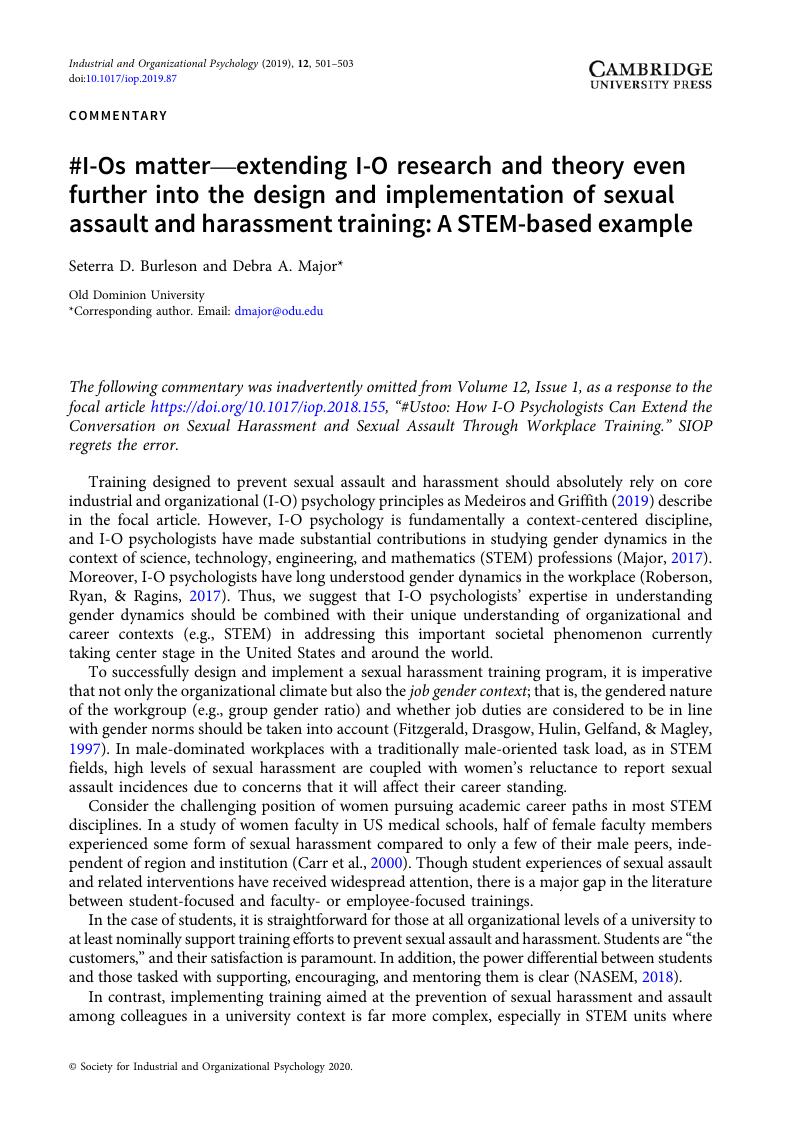No CrossRef data available.
Article contents
#I-Os matter—extending I-O research and theory even further into the design and implementation of sexual assault and harassment training: A STEM-based example
Published online by Cambridge University Press: 14 January 2020
Abstract
An abstract is not available for this content so a preview has been provided. Please use the Get access link above for information on how to access this content.

- Type
- Commentaries
- Information
- Copyright
- © Society for Industrial and Organizational Psychology 2020
References
Anderson, L. A., & Whiston, S. C. (2005). Sexual assault education programs: A meta-analytic examination of their effectiveness. Psychology of Women Quarterly, 29(4), 374–388. doi: 10.1111/j.1471-6402.2005.00237.xCrossRefGoogle Scholar
Carr, P. L., Ash, A. S., Friedman, R. H., Szalacha, L., Barnett, R. C., Palepu, A., & Moskowitz, M. M. (2000). Faculty perceptions of gender discrimination and sexual harassment in academic medicine. Annals of Internal Medicine, 132(11), 889–896. doi: 10.7326/0003-4819-132-11-200006060-00007CrossRefGoogle ScholarPubMed
Dasgupta, N., & Stout, J. G. (2014). Girls and women in science, technology, engineering, and mathematics: STEMing the tide and broadening participation in STEM careers. Policy Insights from the Behavioral and Brain Sciences, 1(1), 21–29. doi: 10.1177/2372732214549471CrossRefGoogle Scholar
Fitzgerald, L. F., Drasgow, F., Hulin, C. L., Gelfand, M. J., & Magley, V. J. (1997). Antecedents and consequences of sexual harassment in organizations: A test of an integrated model. Journal of Applied Psychology, 82(4), 578–589. doi: 10.1037/0021-9010.82.4.578CrossRefGoogle ScholarPubMed
Fitzgerald, L. F., Shullman, S. L., Bailey, N., Richards, M., Swecker, J., Gold, Y., … Weitzman, L. (1988). The incidence and dimensions of sexual harassment in academia and the workplace. Journal of Vocational Behavior, 32, 152–175. doi: 10.1016/0001-8791(88)90012-7CrossRefGoogle Scholar
Gibson, D. B., & Humphrey, C. F. (1993). Educating in regards to sexual violence: An interactional dramatic acquaintance rape intervention. Unpublished manuscript, University of Minnesota, Sexual Violence Program, Minneapolis.Google Scholar
Gruber, J. E. (1998). The impact of male work environments and organizational policies on women’s experiences of sexual harassment. Gender & Society, 12(3), 301–320.CrossRefGoogle Scholar
Hill, C., Corbett, C., & St. Rose, A. (2010). Why so few? Women in science, technology, engineering, and mathematics. Washington, DC: American Association of University Women.Google Scholar
Lonsway, K. A., & Kothari, C. (2000). First year campus acquaintance rape education evaluating the impact of a mandatory intervention. Psychology of Women Quarterly, 24(3), 220–232. doi: 10.1111/j.1471-6402.2000.tb00203.xCrossRefGoogle Scholar
Major, D. A. (2017, April). Gender: Increasing the participation and persistence of women in STEM. In Henderson, A. A. & Matthews, R. A. (co-chairs), Hot Topics in Diversity and Inclusion in Organizations, IGNITE session presented at the 32nd Annual Conference of the Society for Industrial and Organizational Psychology, Orlando, FL.Google Scholar
Malamuth, N. M., Huppin, M., & Linz, D. (2018). Sexual assault interventions may be doing more harm than good with high-risk males. Aggression and Violent Behavior, 41, 20–24. doi: 10.1016/j.avb.2018.05.010CrossRefGoogle Scholar
Medeiros, K., & Griffith, J. (2019). #Ustoo: How I-O psychologists can extend the conversation on sexual harassment and sexual assault through workplace training. Industrial and Organizational Psychology: Perspectives on Science and Practice, 12(1), 1–19.CrossRefGoogle Scholar
Myers, D. P., & Major, D. A. (2017). Work–family balance self-efficacy’s relationship with STEM commitment: Unexpected gender moderation. Career Development Quarterly, 65(3), 264–277. doi: 10.1002/cdq.12097CrossRefGoogle Scholar
National Academies of Sciences, Engineering, and Medicine (NASEM). (2018). Sexual harassment of women: Climate, culture, and consequences in academic sciences, engineering, and medicine. Washington, DC: The National Academies Press. doi: 10.17226/24994.Google Scholar
Rhoton, L. A. (2011). Distancing as a gendered barrier: Understanding women scientists’ gender practices. Gender & Society, 25(6), 696–716. doi: 10.1177/0891243211422717CrossRefGoogle Scholar
Roberson, Q., Ryan, A. M., & Ragins, B. R. (2017). The evolution and future of diversity at work. Journal of Applied Psychology, 102(3), 483–499. doi: 10.1037/apl0000161CrossRefGoogle ScholarPubMed


